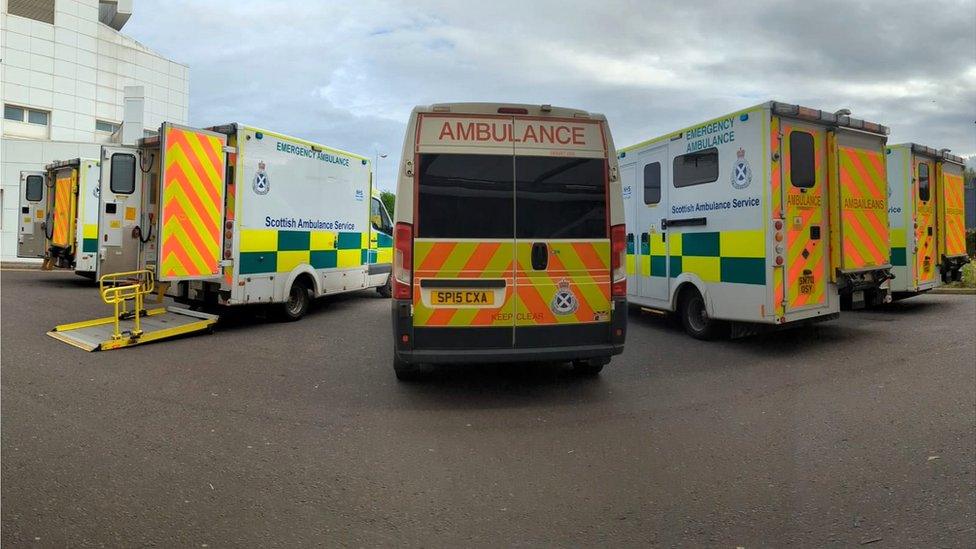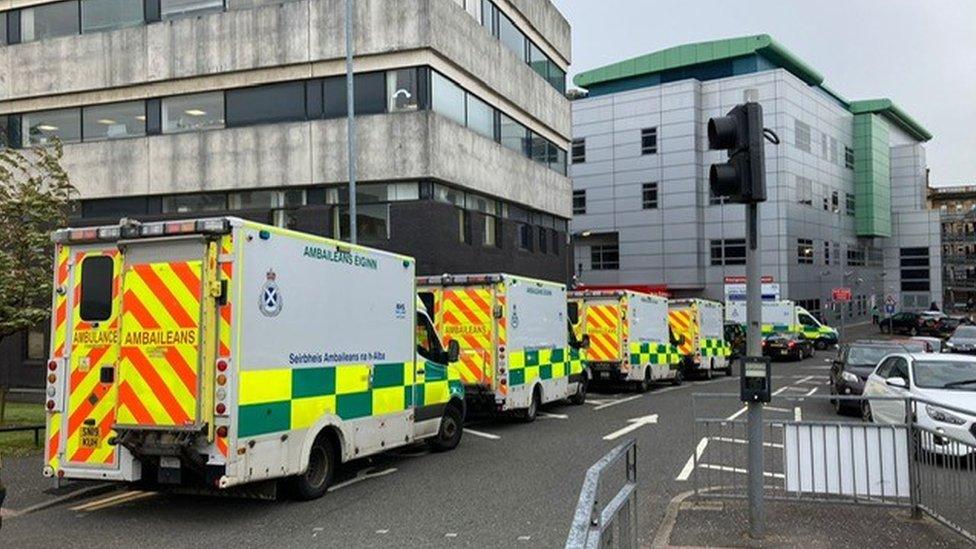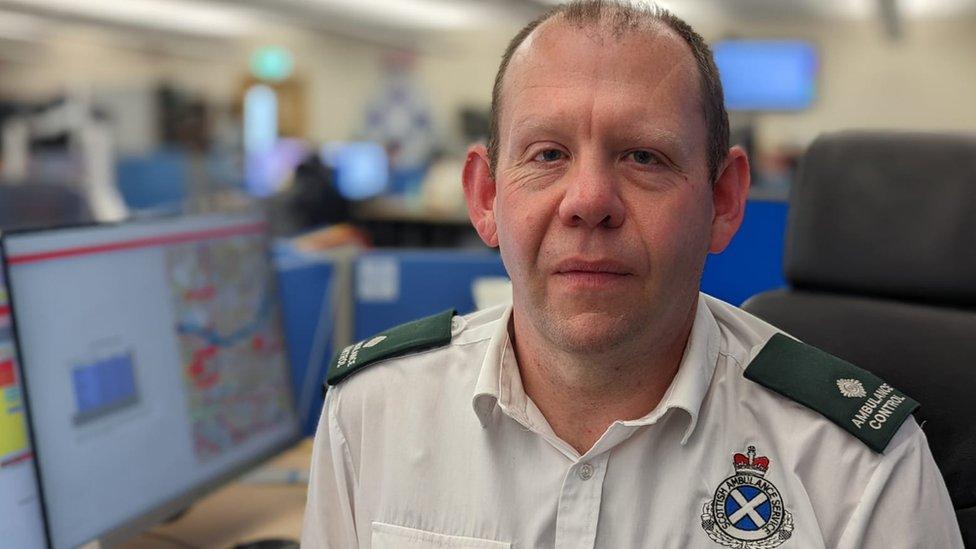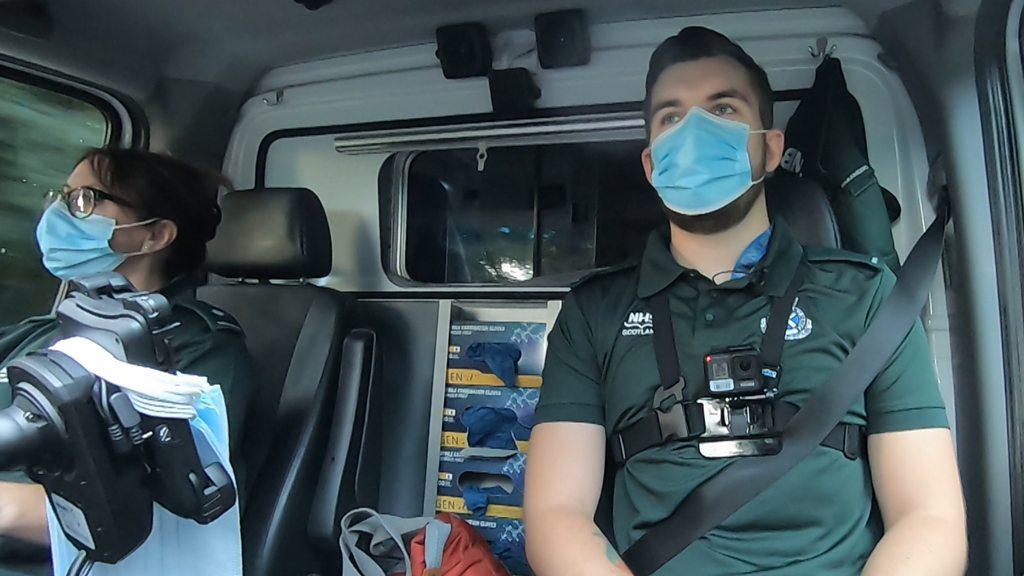Crowded A&Es mean Scottish paramedics play the waiting game
- Published
Paramedics Moira Shaw and Blair Paul worry for patients facing long waits for an ambulance
Paramedic Moira Shaw is eyeing the frantic activity at the front doors of Edinburgh's emergency department.
She is waiting for the go-ahead to hand over her patients to medics and answer the next 999 call.
It can be a long wait.
Last week, one in 10 ambulances across Scotland took more than 80 minutes to drop patients at an emergency department.
BBC Scotland joined Moira and colleague Blair Paul at the Royal Infirmary of Edinburgh where they were among seven ambulances waiting to drop off patients.
"At the moment we can be an hour waiting, we sit in the ambulance and we wait until there is a space to go in," explains Moira, who has been with the service for nearly a decade.
"This is pretty much an everyday occurrence now.
"It's that domino effect, so if patients are waiting to move to other areas, A&E gets clogged up and they can't take any more patients in because they are waiting to move people on.
"It's really frustrating, we feel bad for the patient."

Ambulances parked outside the Royal Infirmary of Edinburgh on 4 May
Moira said she has noticed they are attending more calls where people have not been able to get through to their GP so phone 999 instead.
Another theme picked up by Moira and her colleague Blair is helping younger sicker patients who need urgent hospital treatment.
"I've seen actually quite a lot of people maybe in their 40 or 50s who have got now stage four cancer and they've just not been able to get access to any treatments or anything just due to the pressures on the NHS at the moment," explained Blair.
Waiting times in emergency departments have been among the worst on record in recent months as the NHS deals with the Covid pandemic and staff absences.
The Scottish Ambulance Service says the delays getting patient into hospital pose a "significant challenge".

Ambulances queue outside Glasgow Royal Infirmary on 10 May
Latest figures from the service , externalshow that for the week to 25 April, one in 10 ambulances in Scotland waited over one hour and twenty minutes to drop patients at an emergency department.
At the Royal Infirmary in Edinburgh that figure was just over one hour.
In Glasgow at the Queen Elizabeth University hospital it was two hours and 13 minutes. At the Glasgow Royal Infirmary it was one hour.
And in Ayrshire, one in 10 ambulances at Crosshouse Hospital, waited over three hours before getting back on the road.
Pauline Howie, chief executive of the Scottish Ambulance Service, said: "Hospital turnaround times continue to be a significant challenge across Scotland and are restricting the ability of our staff to get back out to help other patients.
"We're working alongside health boards to try and help mitigate wait times through joint escalation plans and increasing alternative care pathways for ambulance clinicians to support patients in the community."

Scottish Ambulance Service call handling supervisor Alan Lomas says he finds it difficult to tell patients they can face a long wait
The Scottish Ambulance Service has been operating at its highest level of alert since October last year but there are some indications that the situation is improving.
This week it moved from this highest level, meaning there are "critical pressures" on the service, to the level below, which means it is facing "significant pressures".
Alan Lomas, a call handling supervisor at the service's control room, said it is not easy for staff who have to tell patients they face a long wait.
"It's heart-breaking when we see that because we genuinely want to get an ambulance there as quickly as we can," he explained.
"It can be very difficult particularly if it is repeat call after repeat call after repeat call, and you're telling them your sorry, we can't get an ambulance to you."
Related topics
- Published11 November 2021

- Published29 March 2022

- Published15 September 2021
